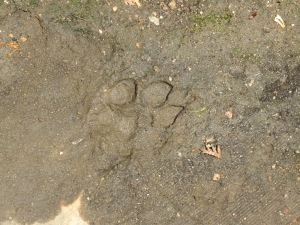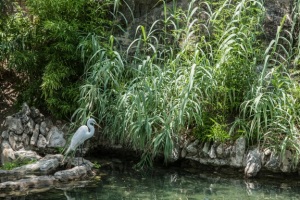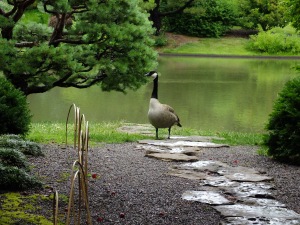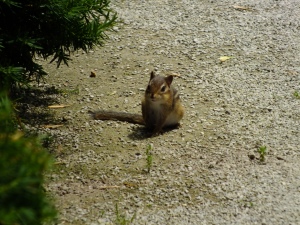
Whispering Woods Serenity Circle
(photo by Bill F. Eger)
“We all need a place where we can get away from the hustle and stress of life, a place of peace and tranquility. When we find that place, we find strength. The Rosecrance Serenity Garden is such a place. These gardens are meant to be a part of the healing process offered by this incredible facility where miracles happen,” stated John Anderson, philanthropist.
Serenity Garden is located on the grounds of the Rosecrance Griffin Williamson Campus, an adolescent treatment center in Rockford, Illinois. The new 50 acre campus, which opened in 2004, includes this six acre garden designed by Hoichi Kurisu to provide a healing environment to nourish ongoing recovery for youth and their families.

welcoming waterfall near the entrance — a feature sometimes not noticed when a person enters treatment, but frequently noticed when they leave
Through the Experiential Therapies Department, the garden is used for guided meditation to help adolescents relax and reflect on recovery. Every week, the young people become aware of their basic senses: sight, sound, taste, touch and smell.
It is the setting for family visits, individual counseling, private journaling and other contemplative activities. The overall objective of horticultural therapy is to cultivate physical and emotional stability and spiritual awareness through nature in a structured environment.

K.T. typing one-handed on her iPad while interviewing Christine
“This garden is designed around the healing qualities of a Japanese garden integrated with the 12 steps of recovery,” said Christine Nicholson, Experiential Therapies Supervisor.
“Each week we deal meditation techniques designed to teach our young people how to be at peace with the calm and ‘boredom’ known as serenity.
“One week I might ask them ‘What kind of water are you?’ which always gets them going. Raindrop, waterfall, ocean wave – it’s a way to get them thinking about the world outside their heads,” Nicholson said.

cedar Serenity Bridge, #6 on the map
(photo by Bill F. Eger)
Being in a garden with streams, waterfalls and a large pond offers several examples as well as an abundance of locations for group and solitary activities. Kurisu describes boulders as the garden’s bone structure and water as the lifeblood running through it.
“As you stand on the deck, you view the action of the waterfall. We watch it come down to the calm surface and feel the serenity of the pond. It reminds us that we are never alone in the universe,” said Kurisu.

Cascading Waterfall, item #9 on the map
“Another week, I may say, ‘You are the earth. How do people walk on you? As the earth, how do you give to people,” Nicholson said.
“One teenager described the activity of raking gravel as ‘massaging my brain’.”

bell used in graduation ceremonies, item #5 on map
“Life’s Waiting” carved in stone at the base of the bell tower is the motto of Rosecrance.
(photo by Bill F. Eger)
A graduation ceremony involves ringing the bell in recognition of the ancient tradition of seeking purification within a sacred place and the desire for a balanced life. A new element of crossing the bridge will be added to graduation ceremonies, according to Nicholson.
Healing Garden Tour [text and map courtesy of Rosecrance]

1. Wooden bridge: this is where an Acer palmatum dissectum adds a splash of red to an otherwise green palette.

Acer palmatum dissectum recently trimmed
(photo by Bill F. Eger)
2. Courtyard and serenity circle: Serenity circles are places where residents, families and visitors can pause to reflect and view the garden. This is the largest and most formal of the serenity circles. The stream running through the courtyard makes 12 drops (for the 12 Step Program) before reaching the pond.
3. Winding walk: Curves in the path remind users that the journey is not straight and life reveals itself slowly. At the peak of the walk is Peaceful Passage Serenity Circle.
4. The pond: The pond, which is 13’ deep at the center, is supplied with both rain and city water. Koi, bluegill and bass thrive in the pond. From the landing, you can take in the full scope of the pond, formal garden, mountain waterfall and natural forest backdrop.
5. Bell tower: When an adolescent successfully completes treatment, the bell is struck as an announcement to the community.
6. Serenity bridge: This bridge is pitched like a mountain because one must work to get to a better place. The use of cedar, an aromatic wood, engages another one of the senses.

Similar to the flagstone bridge mentioned in #7, this bridge is in the #2 courtyard.
(photo by Bill F. Eger)
7. Open stone bridge: The flagstone walkway over the river is deceptive to the eye, giving the appearance of being fragile, but holding great strength.

# 8 on map, Stepping Stone bridge
8. Stepping Stone bridges: At the top and bottom of the waterfall, a stepping stone bridge invites you to cross the flowing water safely. This fall also makes 12 drops before a final plunge into the pond.
9. Cascading waterfall: In the style of a Japanese garden, water in our Healing Garden flows only in a way that is totally natural. Anchored by a 40-ton boulder, the large waterfall moves more than 1,200 gallons of water per minute. The falling water strikes the stones in three locations, adding depth of sound. A “guardian stone,” the protector of the garden, juts out of the pool at the waterfall’s base.
10. Grateful outlook: The highest point of the garden represents the top of the mountain. To observe the natural woods beyond the garden, you must look through the evergreen trees, which form a natural frame for the scene. Note how the sound of the waterfall is muffled by the stones.

weeping willow at the tip of the peninsula
(photo by Bill F. Eger)
11. The peninsula: The peninsula is a reminder of the island nation of Japan where water and land intertwine.
12. Cobblestone bridge: Water from the winding river flows under the bridge to the tranquil pond.

minimally structured path into the woods
(photo by Bill F. Eger)
Healing Gardens
“A healing garden is a natural space that has a therapeutic effect on those who are open to the experience. In a healing or serenity garden there is a deliberate acknowledgement that not all healing is the result of medicine or treatment. Sometimes it comes from unexpected places such as through a connection to the natural world. The elements of the garden engage all of our senses. They offer a positive distraction to everyday life, encourage interaction and provide a connection with nature’s rhythms.” From Rosecrance Serenity Garden overview.
“There is a tremendous grace and energy inherent in such ancient rhythms,” said Kurisu. “At once calming and exuberant, the natural elements remind one of how it is possible to feel, to breathe, to live with inspiration – hastening the rediscovery of a self in harmony with a world not chaotic and destructive, but full of regenerative potential.”

split log bench
The History of Rosecrance
Dr. and Mrs. James Rosecrance left provisions in 1916 for their homestead to become an orphanage for boys. Today, Rosecrance provides help, hope and recovery to families who struggle with alcohol and other drug addictions.
“We believe that addiction to alcohol and other drugs is a chronic, primary and progressive disease with multiple causes that affect the social, physical, cultural and emotional components of an individual’s life. Successful treatment requires a comprehensive program to address problems and prepare for a lasting recovery. Our programs are based on the disease model of addiction and the 12 Step treatment philosophy.”
For more information, go to the Rosecrance web site:
http://www.rosecrance.org
Photos not otherwise credited in this blog are by K.T. Cannon-Eger. Click on any image for a full size view.
Rosecrance is a smoke-free campus. This private garden generally is open 8 a.m. to 8 p.m. on weekdays, 8 a.m. to 4:30 p.m. on weekends.
Check in with the reception desk is required to secure a visitor’s badge and sign a liability waiver before touring the gardens. The receptionist must be notified if you wish to take photographs. The final general rule is “Stay on the path.”











































